Home
Categories
Dictionary
Glossary
Download
Project Details
Changes Log
What Links Here
FAQ
License
Framework UDP tutorial
1 Overview
2 Architecture
3 XML configuration
3.1 First framework instance
3.2 Second framework instance
3.3 Start the two frameworks
4 Specify the Network configuration between the two framework instances
4.1 First framework instance
4.2 Second framework instance
5 Start the two frameworks with the Network configuration
6 See also
2 Architecture
3 XML configuration
3.1 First framework instance
3.2 Second framework instance
3.3 Start the two frameworks
4 Specify the Network configuration between the two framework instances
4.1 First framework instance
4.2 Second framework instance
5 Start the two frameworks with the Network configuration
6 See also
This tutorial reuse the first tutorial, but the two modules are in two different framework instances.
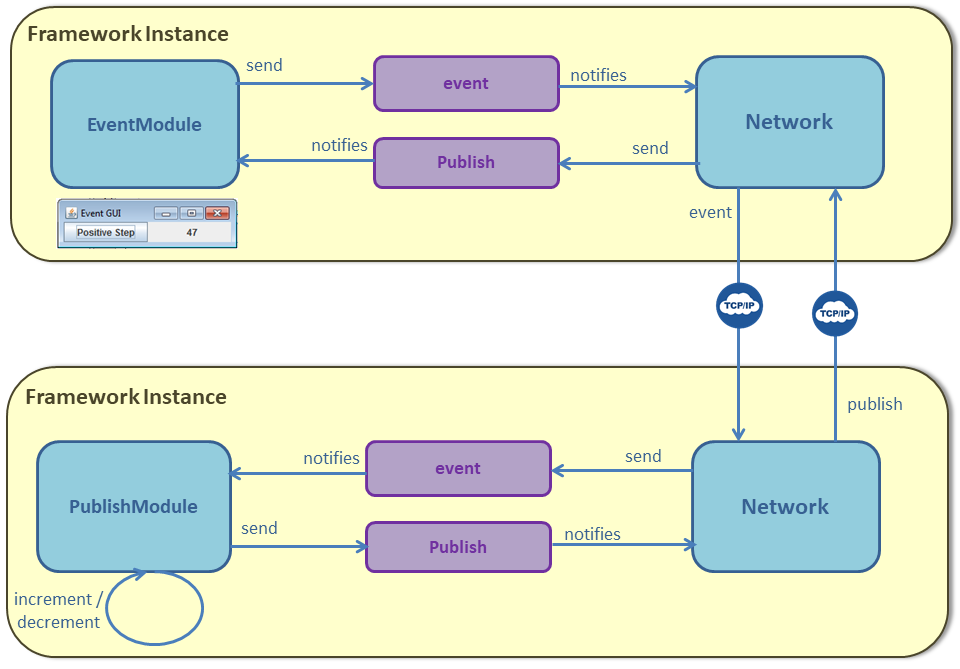
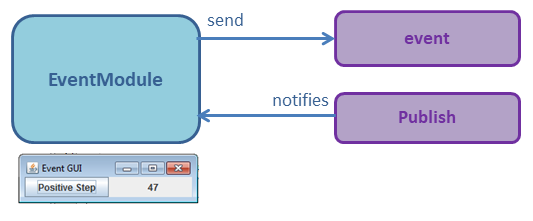
We will call it from a specific filelist configuration:
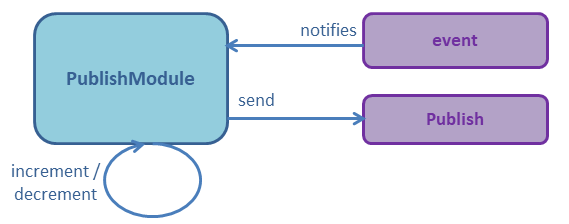
We will call it from another specific filelist configuration:
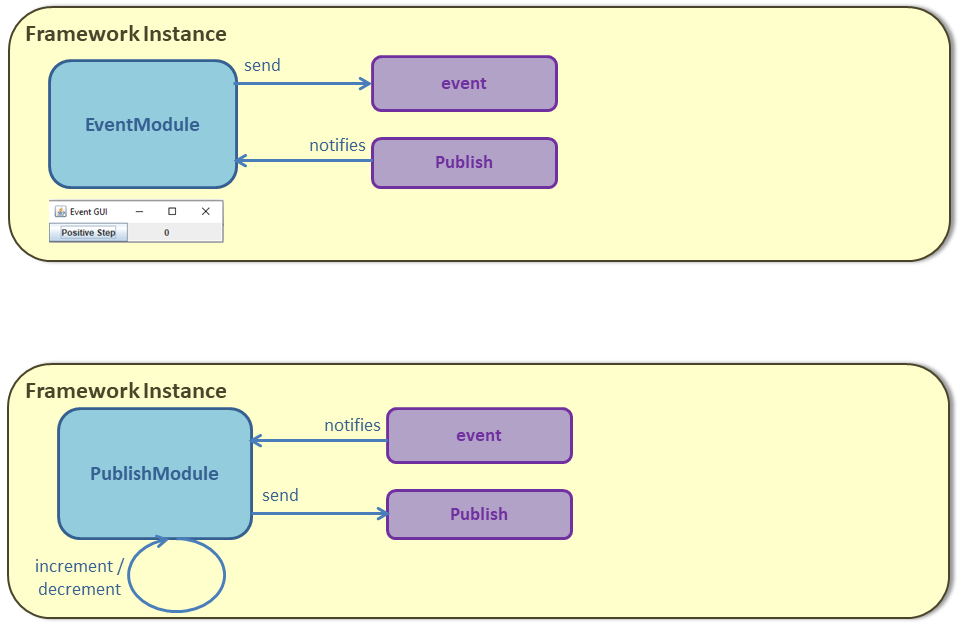
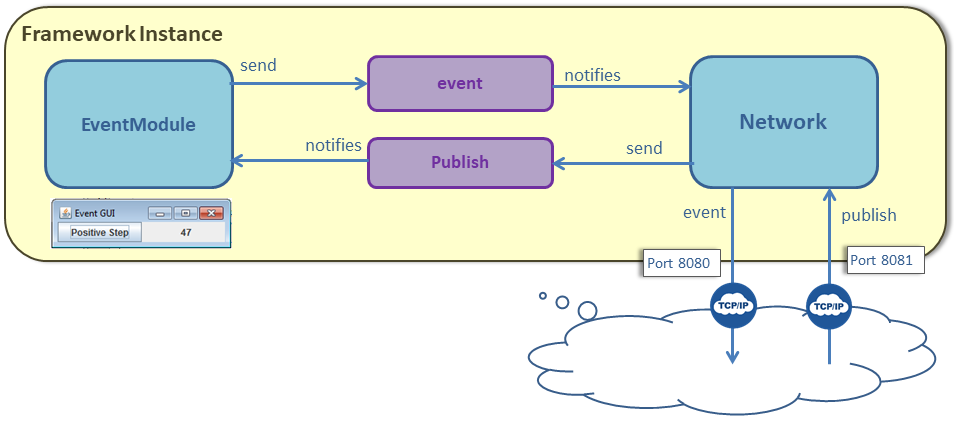
The network configuration will be:
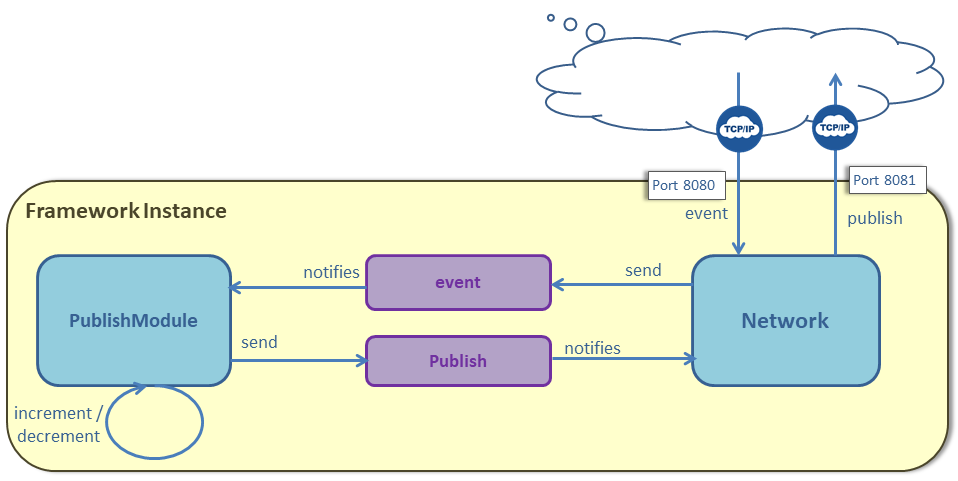
The network configuration will be:
Overview
In the first tutorial, we had two modules:- The
PublishModulemodule increments or decrements a value cyclically - The
EventModulemodule allows to click on a toggle to set if the first module should increment or decrement the value, and shows the value
Architecture
We won't change anything for theservices or types configuration of the first tutorial, but we will separate the modules in two applications configurations. We will:- Put the
EventModulein one framework instance - Put the
PublishModulein another framework instance

XML configuration
Only theapplications.xml XML files has to be modified. We will define one file for each framework. The code is not impacted.
First framework instance
The first framework instance only has theEventModule:<applications> <application name="eventAppli"> <deployment> <lib url="samplesEvent.jar" /> </deployment> <modules> <module name="EventModule" id="1" > <implementation path="org.da.samples.protoframework.event.EventModule" > <initEntryPoint method="init" /> <defaultReceiveEntryPoint method="subscribe" /> </implementation> <interfaces> <eventSend service="event" attach="attach"/> <subscribe service="published" /> </interfaces> </module> </modules> </application> </applications>

We will call it from a specific filelist configuration:
<files> <file url="applicationEvent.xml" /> <file url="services.xml" /> <file url="types.xml" /> </files>
Second framework instance
The second framework instance only has thePublishModule:<applications> <application name="publishAppli"> <deployment> <lib url="samplesPublish.jar" /> </deployment> <modules> <module name="PublishModule"> <implementation path="org.da.samples.protoframework.publish.PublishModule" > <initEntryPoint method="init" /> <defaultReceiveEntryPoint method="subscribe" /> <defaultSendEntryPoint method="publish" /> </implementation> <interfaces> <eventReceived service="event"/> <cyclic service="published" frequency="200ms" attach="attach"/> </interfaces> </module> </modules> </application> </applications>

We will call it from another specific filelist configuration:
<files> <file url="applicationPublish.xml" /> <file url="services.xml" /> <file url="types.xml" /> </files>
Start the two frameworks
To start the first framework instance, we use our first filelist configuration file for our configuration:
java -jar protoframework.jar config=filelistEvent.xml
To start the second framework instance, we use our second filelist configuration file for our configuration:
java -jar protoframework.jar config=filelistPublish.xml
However as the two framework instances do not communicate, nothing happens on the GUI for the moment:
Specify the Network configuration between the two framework instances
To allow the two framework instances to communicate, we will define a network configuration for each of the instances.First framework instance
We will create a network configuration for the first framework instance. We need to create two Channels:- One Channel to send the
eventService - One Channel to receive the
publishService

The network configuration will be:
<network> <channel name="event" type="output" port="8080" size="1000"> <service name="event" /> </channel> <channel name="publish" type="input" port="8081" size="1000"> <service name="published" /> </channel> </network>We also need to specify the Network file on our first filelist configuration file:
<files> <file url="applicationEvent.xml" /> <file url="services.xml" /> <file url="types.xml" /> <file url="networkEvent.xml" /> </files>
Second framework instance
We will create a network configuration for the second framework instance. We need to create two Channels:- One Channel to receive the
eventService - One Channel to send the
publishService

The network configuration will be:
<network> <channel name="event" type="input" port="8080" size="1000"> <service name="event" /> </channel> <channel name="publish" type="output" port="8081" size="1000"> <service name="published" /> </channel> </network>We also need to specify the Network file on our second filelist configuration file:
<files> <file url="applicationEvent.xml" /> <file url="services.xml" /> <file url="types.xml" /> <file url="networkPublish.xml" /> </files>
Start the two frameworks with the Network configuration
To start the first framework instance, we use our first filelist configuration file for our configuration:
java -jar protoframework.jar config=filelistEvent.xml
To start the second framework instance, we use our second filelist configuration file for our configuration:
java -jar protoframework.jar config=filelistPublish.xml
Now the two applications are behaving exactly as for the first tutorial.See also
- Tutorials: This tutorial reuse the first tutorial, but the two modules are in two different framework instances
- Network configuration: This article explains how the network configuration is specified
- Java modules: Java modules are the default modules type
×
![]()
Categories: tutorials